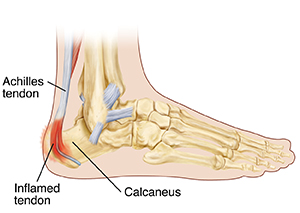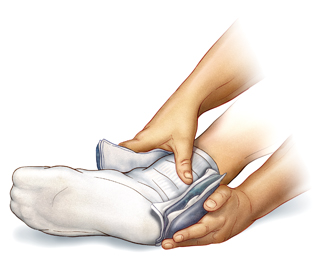A
B
C
D
E
F
G
H
I
J
K
L
M
N
O
P
Q
R
S
T
U
V
W
X
Y
Z
Click a letter to see a list of medical procedures beginning with that letter.
Click 'Back to Intro' to return to the beginning of this section.
When Your Child Has Sever Disease
Your child has been diagnosed with Sever disease. This is an irritation of the area where the Achilles tendon attaches to the heel (calcaneus). Constant pulling on the Achilles tendon causes the area to become inflamed. This condition is painful. But with correct care, it can be treated.

What causes Sever disease?
Activities that require a lot of running and jumping cause the Achilles tendon to pull on the heel. This can lead to soreness and pain. Sports, such as basketball and soccer, put players at risk of Sever disease.
What are the symptoms of Sever disease?
Symptoms often appear at the beginning of a sports season. This is because the tendons and muscles aren’t ready for the stress of running and jumping. Symptoms include:
-
Heel pain with activity
-
Heel pain after activity
-
Limping
How is Sever disease diagnosed?
The healthcare provider will ask about your child's health history and examine your child. During the exam, the healthcare provider checks your child's heel for tenderness and pain. An X-ray may also be taken to evaluate the heel bone and rule out other problems.
How is Sever disease treated?
 |
| Resting and icing the heel can help relieve pain. |
The healthcare provider will talk with you about the best treatment plan for your child. As instructed, your child will:
-
Ice the heel 3 to 4 times a day for 15 to 20 minutes at a time. To make an ice pack, put ice cubes in a plastic bag that seals at the top. Wrap the bag in a clean, thin towel or cloth. Never put ice directly on your child's skin.
-
Take anti-inflammatory medicine, such as ibuprofen, as directed.
-
Decrease the amount physical activity, such as running and jumping, your child does until there is no discomfort or significant pain afterwards. This may need several months in some cases.
-
Stretch the heels and calves, as instructed by the healthcare provider. Regular stretching can help prevent Sever disease from coming back.
-
Use a “heel cup” or a cushioned shoe insert that takes pressure off the heel.
In some cases, a walking boot may be needed to immobilize the foot while it heals.
What are the long-term concerns?
With correct treatment, the injury should heal without any long-term concerns. Sever disease may happen once again when the child increases sports activities, but rarely recurs once the child is fully grown.
Online Medical Reviewer:
Rahul Banerjee MD
Online Medical Reviewer:
Raymond Turley Jr PA-C
Online Medical Reviewer:
Rita Sather RN
Date Last Reviewed:
4/1/2024
© 2000-2024 The StayWell Company, LLC. All rights reserved. This information is not intended as a substitute for professional medical care. Always follow your healthcare professional's instructions.